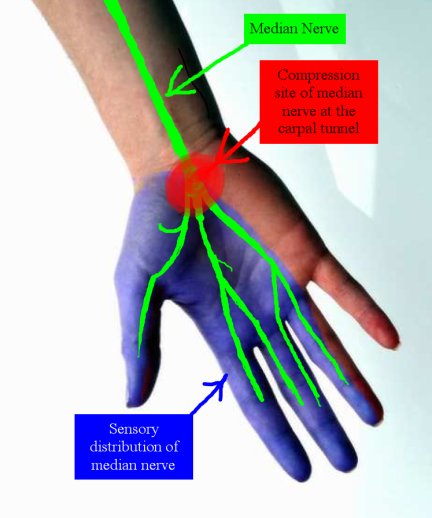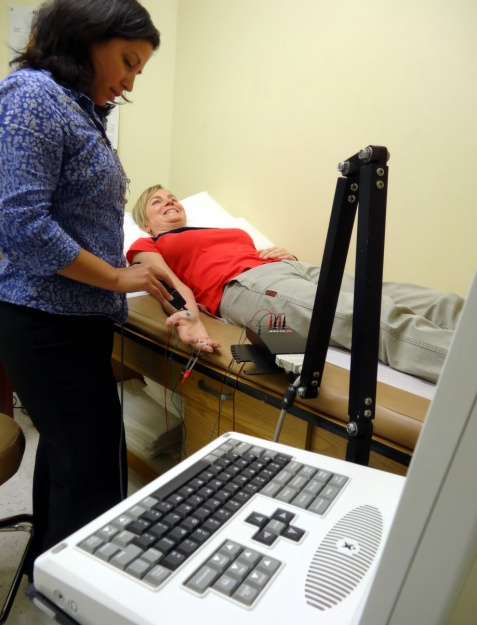
As temperatures drop this season, you may begin to feel more pain or swelling in your muscles and joints. And if you're like the 86% of American's who work at a desk all day, you might feel the symptoms of carpal tunnel syndrome.
Carpal tunnel syndrome (CTS) is considered one of the most common diagnoses in patients that present with hand pain and numbness. Simply stated, it is a condition where one of the main nerves of the hand, the median nerve, is compressed at the carpal tunnel causing symptoms typically seen in carpal tunnel syndrome. Multiple tendons that originate from the forearm that help bend your fingers and wrist and the median nerve pass through the carpal tunnel. The tunnel is composed of the carpal bones (bones of the wrist) and the transverse carpal ligament that forms a band across the base of the palm and wrist. Any condition that results in compression of the median nerve at this location is classified as Carpal Tunnel Syndrome. (see diagram)
Symptoms:
Symptoms of Carpal Tunnel usual start gradually. This includes: pain, tingling, burning and/or numbness in the hand and fingers. The numbness and tingling is usually first noted in the thumb, index and middle finger. It tends to spare the 5th digit (little finger). You may encounter cramping of the hand and fingers.
Patients often complain of awakening at night with the hand asleep or hand falling asleep when driving or doing a prolonged activity. Patients sometimes mention clumsiness of the hand and dropping things easily. These symptoms may also refer up the forearm and, if severe enough, to the shoulder area. If left untreated, in advanced or chronic cases, it may progress to develop weakness of the hand grip with muscle wasting (loss) under the thumb in the area known as the thenar eminence.
Causes and Risks:
Any condition that results in narrowing of the space inside the carpal tunnel compressing or irritating the median nerve can cause CTS. The most common risks include repetitive activity or trauma; repeated pressure at the wrist like resting the wrist on edge of a keyboard, overuse of the hand with prolonged typing, working in manufacturing line, using power tools that vibrate and cause injuries to the wrist and hand area.
Additional causes include swelling of the tendons, (known as tenosynovitis), rheumatoid arthritis which causes swelling of local tissue and joints; swelling during pregnancy, (usually during second and third trimester), infections and other space occupying lesions like a ganglion cyst. Women are at higher risk to develop CTS than men and sometimes there is no identifiable cause.
Testing for Carpal Tunnel Syndrome:
The first step in properly diagnosing this condition is a taking a thorough history by your physician followed by a physical exam looking at the different possible conditions that could cause your
symptoms. This is then followed by an electrodiagnostic study (shown on the right), also known as Nerve Conduction Study and Electromyography (NCS/EMG). There are many conditions that can mimic CTS, so the electrodiagnostic study is essential.
Inform yourself of who is performing your study. Electrodiagnostic studies should be conducted by physicians specialized in physiatry or neurology. If the NCS tests component is performed by a qualified technician, this should be performed in direct supervision of a trained physician in the field of electrodiagnostic medicine, and the EMG should only be performed by the trained physician. Unfortunately, unqualified physicians and non-physicians perform these tests and this may result in erroneous diagnosis which may result in unnecessary discomfort and improper treatment.
Treatment:
Usually begins with the avoidance of the activity causing the problem, such as stopping repetitive motion, and using proper ergonomics in the work station. The use of a wrist splint at night and anti-inflammatory drugs are commonly prescribed in order to relieve pain and swelling. Your physician may order Occupational Therapy (OT). More aggressive intervention would consist of corticosteroid injection in the wrist. If symptoms do not resolve with conservative intervention then your physician may recommend carpal tunnel release surgery.
Because of the many conditions that can mimic CTS, surgery should not be performed unless the diagnosis is verified with an electrodiagnostic study. The surgery is commonly performed in an out-patient surgical center with regional anesthesia by an orthopedic surgeon or neurosurgeon. Note that the surgery is performed in order to release the pressure on the median nerve. The surgeon may decide to do an open surgery, making a larger incision in the palm for direct visualization of surgical field, or an endoscopic surgery, using a small endoscope through a small incision in your wrist or hand. Although carpal tunnel release surgery, in patients with mild to moderate conditions, tend to have a good outcome, it may take several months for the strength and numbness to resolve. In some cases where the condition is severe or not properly diagnosed the condition may not resolve.
If CTS is ignored or not properly treated, it may result in permanent pain, numbness, weakness and impairment. Surgical risks include but are not limited to: no improvement, increase pain due to injury of nerve or vascular structure, bleeding, infection, and scar sensitivity.
The information and recommendations appearing on this article are appropriate in most instances, but are not substitutes for proper medical evaluation and diagnosis.
If you are experience the symptoms of carpal tunnel or need medical advice, click here to request an appointment with one of our physicians, either in our Physical Medicine & Rehabilitation Medicine Division or Neurology Division.
This article was written by Dr. Rigoberto Puente-Guzman

